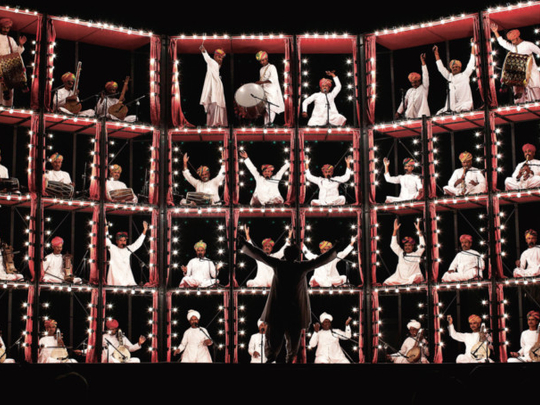
When the Punjabi Sufi legend Bulleh Shah composed his kafi (poetry) Alfat Un Bin In Bin nearly 300 years ago, he wouldn’t have imagined it being performed in a grand theatrical apparatus with 36 musicians in tow.
But Roysten Abel’s Manganiyar Seduction — which was on show at the Dubai Media City Amphitheatre on November 7 — is all about subverting the traditional presentation of music to celebrate the classical ballads of one of India’s most talented tribe of folk musicians. Unlike typical visual journeys where music plays the second fiddle to stage acts, Abel’s interpretation of Manganiyar melodies ensures that the music is the focus of the production.
The Manganiyars, a caste of Muslim musicians from the deserts of Rajasthan, are said to trace their roots back to the Rajputs, a fierce warrior tribe from northern India.
The folk music of the Manganiyars has been passed on through generations, creating an oral history of the people, their land and customs. Mostly patronised by kings and landlords during the medieval ages, their ballads narrate the full gamut of life — from tragic love stories to the conquests of Alexander the Great to devotional songs. In local communities in Rajasthan, their music is mandatory in weddings and all other family festivities. But like many other traditional folk music tribes across India, such as the Bauls of Bengal, the Manganiyars were relegated to virtual neglect until the early 1980s.
It is this dying breed of musicians that Abel resurrects successfully in the Manganiyar Seduction.
The stage comprises a dramatic four-tier structure with nine curtained cubicles at each level, within which are ensconced an assortment of Manganiyar musicians and their instruments. The set is inspired in part by Jaipur’s landmark Hawa Mahal (Wind Palace) and the red-light districts of Amsterdam.
Unique medley
The performance begins with a short alap (introduction) in classical style by the lead vocalist from a single illuminated cubicle. As more vocalists and musicians join in, their cubicles begin to light up, creating a unique medley of visual and aural experience.
As with the music, the instruments deployed by the Manganiyars are also deeply rooted in Rajasthani tradition — the 17-string khamaycha (a bowed instrument resembling the mandolin); the dholak (drums); the traditional Indian flute and the been (wind instrument); the kartal (teakwood castanet) and the Indian jaw harp. And conducting such a varied folk orchestra with each performer seated in a cubicle without any visual access to each other is no mean feat — but Abel excels in managing the intuitive flow of melodies throughout the concert.
Unlike the neat cubicles, however, it is far more difficult to define Manganiyar Seduction.
Is it a folk choir? Or an opera with a live orchestra?
The plot — if we may call it so — is rather simple. It’s the refrains of Bulleh Shah’s Alfat Un Bin In Bin, interpreted in various rhythms and styles with digressions from popular Rajasthani folk ballads, that run throughout the show.
Interspersed with brief conversations between various instruments (the ones between the flute and the jaw harp, and the drums and the khamaycha being specially memorable), when the concert reaches its crescendo with all singers and musicians performing in unison, it serves to remind us that such music needs no definition or boundaries.
Perhaps the only thought for the ecstatic audience at the end of the 45-minute seductive music was if there was a second act on offer!











